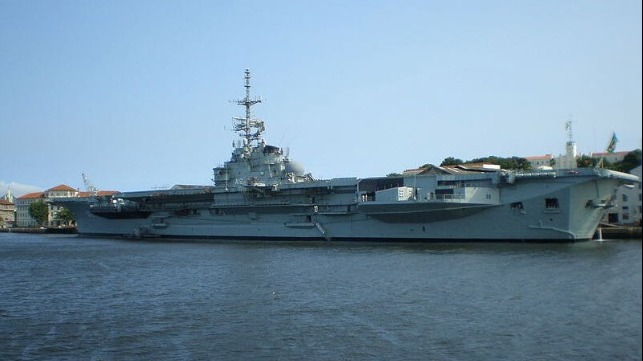“Toxic” Aircraft Carrier Held in Limbo off Brazilian Coast

The saga of the decommissioned Brazilian Navy carrier NAe São Paulo continues as the authorities work to determine the next steps in the efforts to scrap the vessel. Refused by Turkey because of concerns that the vessel is laden with extensive amounts of asbestos and other toxic materials, reports indicate that the vessel after a return tow across the Atlantic has been lingering for three weeks in search of a port and plan for disposal. The NGO Shipbreaking Platform and other environmental groups are calling on Brazil to dock the vessel and finalize a plan for cleaning the vessel of toxic materials.
The ordeal began on August 4, 2022, when the retired carrier departed Rio de Janeiro being towed to Turkey where breakers had acquired the vessel for dismantling. Environmental groups were protesting the export of the vessel reporting that the environmental survey was inaccurate and incomplete. The watchdog organization NGO Shipbreaking Platform contends that only 12 percent of the spaces aboard the carrier had been tested to prepare the report which estimated just 9.6 tons of asbestos-contaminated materials onboard the vessel. The carrier is a sister ship to the French Clemenceau which by comparison the NGO reports contained at least 600 tons of asbestos.
The Brazilian Navy contends that a remediation effort was undertaken years ago. They reported the removal of 55 tons of asbestos from the carrier which they acquired from France in 2000. Brazil operated the carrier for 12 years before a fire took her out of service with reports that Brazil planned to recondition the vessel for active service. Five years later Brazil demobilized the carrier and the following year listed her as decommissioned.
The Brazilian environmental agency IBAMA responded to the outcry and demands from Turkey and other authorities saying that the vessel had already left Brazilian territorial waters, making it impossible to conduct a further survey. In addition, they reported that the carrier had already been sold to the Turkish shipyard Sok Denizcilikve Tic (SOK). Only after the Turkish government refused an import permit, the Brazilian authorities ordered the vessel returned after it had already arrived off Gibraltar. The ocean-going tug towing the carrier was due to arrive back in Brazil at the beginning of October.
"It is time for Brazilian authorities to stop passing the buck and collectively take responsibility for a dangerous situation,” said Nicola Mulinaris, Senior Communication and Policy Advisor at NGO Shipbreaking Platform. “IBAMA is now charged with the environmentally sound management of this ship, and yet it is again failing to ensure this outcome. Meanwhile, we know the Navy has room for the vessel, which should be required to berth immediately. No more games!"
After the carrier reached Brazilian waters on October 5, the NGO charges that IBAMA and the Brazilian Navy failed to act leaving the carrier drifting 12 miles off the coast near Recife and the eastern State of Pernambuco. They report that the State Environment Agency (CPRH) of Pernambuco denied the docking of the carrier at the Port of Suape, located south of Recife, and several other Brazilian facilities approached by SOK also refused a berth citing space concerns or a lack of technical capacity.
AWS Service performed inspections on October 12 and October 14, and according to NGO Shipbreaking Platform concluded that, due to degradation and structural damage as a result of environmental influences, the "immediate mooring/docking is recommended for structural repair, to avoid the expansion of damage and the possible loss of stability for a long period at sea."
The NGOs are calling for the ship to be immediately moored at a port in Brazil. After the vessel is secured, they said Brazil must develop a plan for the safe recycling or reuse of the ship. France faced a similar problem with the disposal of the Clemenceau. After departing at the end of 2005, India denied permission for the vessel to be scrapped at Alang, and France was forced to recall the vessel. It took another four years until an acceptable solution was set up with the vessel ultimately being dismantled in the UK in 2010.
Top photo by Bernardo Fiusa (public domain)
